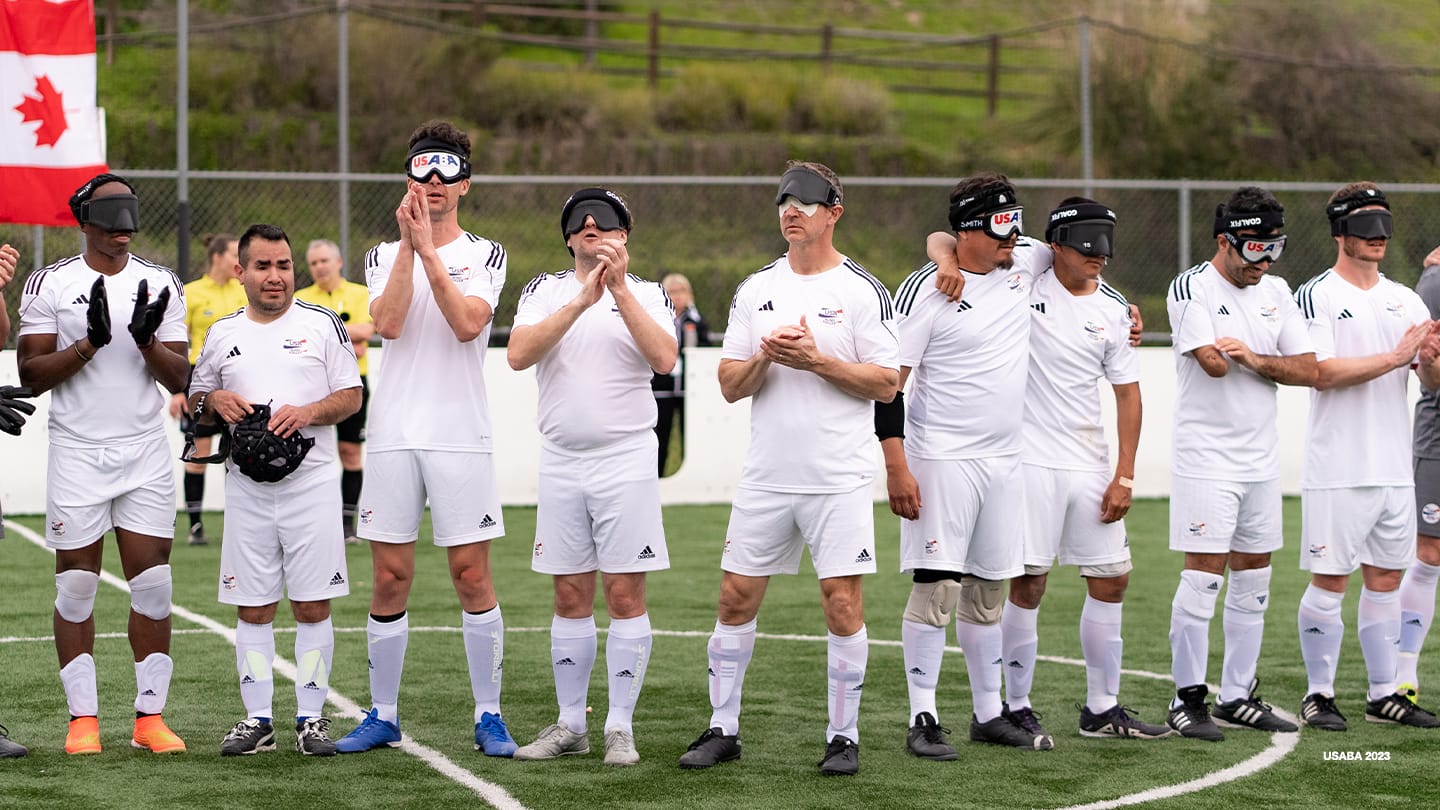
Five-Year Plan: LA28 Presents Unique Opportunity For New U.S. Blind Soccer Team
by Alex Abrams

Athletes from the U.S. men's blind soccer team pose for a photo during a friendly against Canada in Chula Vista, Calif.
Katie Smith likes to tell the story about how she signed up for VI skiing as a graduate student years ago, thinking the VI stood for “very important.”
What Smith didn’t realize until later was that she had agreed to be a guide for visually impaired skiers. It was her awkward introduction to working with blind athletes, and before long she developed a passion for it.
As a former high school soccer player, Smith was excited to learn about blind soccer when she attended a U.S. Association of Blind Athletes soccer camp in 2018. The sport combined her love of soccer with her desire to coach visually impaired athletes.
“I did intramurals in college but nothing competitive,” said Smith, who started playing soccer as a kid growing up in West Chester, Ohio, just outside Cincinnati. “And so it was just good to get back into (soccer) and then being like, ‘Oh, it’s with athletes who are blind and visually impaired, which I already love working with.’
“It’s just like a match made in heaven.”
The stakes are growing higher now for Smith, who is coach of the U.S. blind soccer men’s national team. Blind soccer has been a Paralympic sport since 2004. But, the Americans have never fielded a team — a fact that will change in the next five years when the U.S., as the host nation, gets an automatic berth into the Paralympic Games Los Angeles 2028.
Smith has assembled a coaching staff and a roster that includes eight players and two alternates as they prepare to make their debut on the world’s largest stage in Los Angeles. Though there isn’t a U.S. women’s national team right now, Smith said the Americans expect to field a women’s team by 2028, too.
“I honestly think once 2028 happens, the game is just going to explode from blind athletes hearing from all over the country a little bit more about USA having this sport in the Paralympics,” Smith said.

The U.S. men's blind soccer team in action during a friendly against Canada in Chula Vista, Calif.
In late March, the U.S. men played a pair of friendlies against Canada in Chula Vista, California, winning them both.
Phoenix native Alvaro Mora Arellano broke a scoreless game and had the go-ahead goal in a 1-0 win over Canada on May 19 when he split two defenders and booted a shot into the left side of the net with 6:15 remaining.
The following day, Arellano scored two first-half goals as the Americans cruised to a 3-0 victory over Canada. Noah Beckman, a team captain from Columbus, Ohio, had the final goal with 11:07 left.
“These athletes have been playing together since 2018, so just the ability to play another team and really understand how an international match runs was really really fruitful for myself and for the athletes and especially as we move forward to 2028,” Smith said. “It’s so different being in a game situation than just you all practicing.”
Smith said she hears lots of questions from people who have never heard of blind soccer, especially when she’s traveling with the national team. Strangers will see her and her players wearing shirts with “USA Blind Soccer” printed on them and ask about it.
Blind soccer is like 5-on-5 soccer played on an indoor field with a specially designed soccer ball that makes noise to help visually impaired athletes locate it.
The goalkeepers are the only players on the field who can see. Since the rest of the players can have varying degrees of visual impairment, they’re required to wear eye shades that make it so none of them can see even a little bit of light.
In addition to the ball making noise, there are two coaches on the field — one at midfield and the other by the opposing team’s net — who can communicate with the players and let them know when to shoot. Goalkeepers also let their teammates know what they see.
Smith said defenders will holler, “Voy!” — which is Spanish for “I go!” or “I’m coming!” — to help their teammates know who has possession of the ball.
“Honestly, the rest of the game is just communication, so communication between each team and strategy and understanding their positioning,” Smith said.
Smith said the plan over the next few years is for the U.S. men’s team to hold camps every year, so players can build camaraderie and work on their skills. The team is a mix of players with a soccer background and others new to the sport.
In addition, the Americans want to travel to face more international competition. The goal is to improve to the point where they can compete against the world’s top blind soccer teams, including Brazil, Argentina, France and Japan.
“We are definitely going to be heading internationally 100 percent. A big thing that we are wanting to do is being ranked, for Team USA to be ranked,” Smith said. “… (We want to) make sure our name is out there and that we’re ranked and that we’re getting up to a high ranking, especially before 2028, and playing some of the best competitors in the game as well.”
Alex Abrams has written about Olympic sports for more than 15 years, including as a reporter for major newspapers in Florida, Arkansas and Oklahoma. He is a freelance contributor to TeamUSA.org on behalf of Red Line Editorial, Inc.